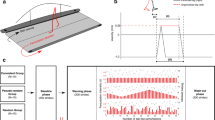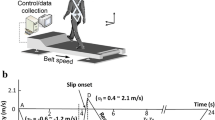Abstract
The properties of adaptation within the locomotor and balance control systems directed towards improving one’s recovery strategy for fall prevention are not well understood. The purpose of this study was to examine adaptive control of gait stability to repeated slip exposure leading to a reduction in backward loss of balance (and hence in protective stepping). Fourteen young subjects experienced a block of slips during walking. Pre- and post-slip onset stability for all slip trials was obtained as the shortest distance at touchdown (slipping limb) and lift-off (contralateral limb), respectively, between the measured center of mass (COM) state, that is, position and velocity relative to base of support (BOS) and the mathematically predicted threshold for backward loss of balance. An improvement in pre- and post-slip onset stability correlated with a decrease in the incidence of balance loss from 100% (first slip) to 0% (fifth slip). While improvements in pre-slip stability were affected by a proactive anterior shift in COM position, the significantly greater post-slip onset improvements resulted from reductions in BOS perturbation intensity. Such reactive changes in BOS perturbation intensity resulted from a reduction in the demand on post-slip onset braking impulse, which was nonetheless influenced by the proactive adjustments in posture and gait pattern (e.g., the COM position, step length, flat foot landing and increased knee flexion) prior to slip onset. These findings were indicative of the maturing process of the adaptive control. This was characterized by a shift from a reliance on feedback control for postural correction to being influenced by feedforward control, which improved pre-slip stability and altered perturbation intensity, leading to skateover or walkover (>0.05 m or <0.05 m displacement, respectively) adaptive strategies. Finally, the stability at contralateral limb lift-off was highly predictive of balance loss occurrence and its subsequent rapid reduction, supporting the notion of the internal representations of stability limits that could be modified and updated, as a key component in the adaptive control.








Similar content being viewed by others
References
Bhatt T, Pai Y-C (2005) Long-term retention of gait stability improvements. J Neurophysiol 94:1971–1979
Bhatt T, Wening JD, Pai Y-C (2004) Feedforward adaptation of gait stability for reduction of backward balance loss. Society for Neuroscience 34th Annual Meeting. San Diego, California, Oct, 23–27
Bhatt T, Wening JD, Pai Y-C (2005) Influence of gait speed on stability: recover from anterior slips and compensatory stepping. Gait Posture 21:146–156
Bhushan N, Shadmehr R (1999) Computational nature of human adaptive control during learning of reaching movements in force fields. Biol Cyberne 81:39–60
Cham R, Redfern MS (2002) Changes in gait when anticipating slippery floors. Gait Posture 15:159–171
Chong RK, Horak FB, Woollacott MH (1999) Time-dependent influence of sensorimotor set on automatic responses in perturbed stance. Exp Brain Res 124:513–519
de Leva P (1996) Adjustments to Zatsiorsky-Seluyanov’s segment inertia parameters. J Biomech 29:1223–1230
Drew T, Jiang W, Widajewicz W (2002) Contributions of the motor cortex to the control of the hindlimbs during locomotion in the cat. Brain Res Rev 40:178–191
Earhart GM, Fletcher WA, Horak FB, Block EW, Weber KD, Suchowersky O, Melvill Jones G (2002) Does the cerebellum play a role in podokinetic adaptation? Exp Brain Res 146:538–542
Forssberg H, Grillner S, Rossingnol S (1975) Phase dependent reflex reversal during walking in the chronic spinal cat. Brain Res 85:103–107
Haruno M, Kuroda T, Doya K, Toyama K, Kimura M, Samejima K, Imamizu H, Kawato M (2004) A neural correlate of reward-based behavioral learning in caudate nucleus: a functional magnetic resonance imaging study of a stochastic decision task. J Neurosci 24:1660–1665
Hiebert GW, Gorassini MA, Jiang W, Prochazka A, Pearson KG (1994) Corrective responses to loss of ground support during walking II Comparison of intact and chronic spinal cats. J Neurophysiol 71:611–622
Horak FB, Diener HC (1994) Cerebellar control of postural scaling and central set in stance. J Neurophysiol 72:479–493
Horak FB, Diener HC, Nashner LM (1989) Influence of central set on human postural responses. J Neurophysiol 62:841–853
Kably B, Drew T (1998) Corticoreticular pathways in the cat II Discharge activity of neurons in area 4 during voluntary gait modifications. J Neurophysiol 80:406–424
Kawato M, Gomi H (1992) A computational model of four regions of the cerebellum based on feedback-error learning. Biol Cybern 68:95–103
Keizer K, Kuypers HG (1989) Distribution of corticospinal neurons with collaterals to the lower brain stem reticular formation in monkey (Macaca fascicularis). Exp Brain Res 74:311–318
Llewellyn MGA, Nevola VR (1992) Strategies for walking on low-friction surfaces. In: Lotens WA, Havenith G (eds) The Fifth International Conference on Environmental Ergonomics. Maastricht, The Netherlands, pp 156–157
Lockhart TE, Woldstad JC, Smith JL (2003) Effects of age-related gait changes on the biomechanics of slips and falls. Ergonomics 46:1136–1160
Maki BE, Whitelaw RS (1993) Influence of expectation and arousal on center-of-pressure responses to transient postural perturbations. J Vestib Res 3:25–39
Marigold DS, Patla AE (2002) Strategies for dynamic stability during locomotion on a slippery surface: effects of prior experience and knowledge. J Neurophysiol 88:339–353
Matsuyama K, Mori F, Nakajima K, Drew T, Aoki M, Mori S (2004) Locomotor role of the corticoreticular-reticulospinal-spinal interneuronal system. Prog Brain Res 143:239–249
McIlroy WE, Maki BE (1993) Changes in early ‘automatic’ postural responses associated with the prior-planning and execution of a compensatory step. Brain Res 631:203–211
McMahon TA (1984) Muscles, reflexes, and locomotion. Princeton University Press, Princeton, New Jersey
Nashner LM (1980) Balance adjustments of humans perturbed while walking. J Neurophysiol 44:650–664
Novak KE, Miller LE, Houk JC (2003) Features of motor performance that drive adaptation in rapid hand movements. Exp Brain Res 148:388–400
Pai Y-C, Wening JD, Runtz EF, Iqbal K, Pavol MJ (2003) Role of feedforward control of movement stability in reducing slip-related balance loss and falls among older adults. J Neurophysiol 90:755–762
Pai Y-C, Iqbal K (1999) Simulated movement termination for balance recovery: can movement strategies be sought to maintain stability even in the presence of slipping or forced sliding?. J Biomech 32:779–786
Pavol MJ, Pai Y-C (2002) Feedforward adaptations are used to compensate for a potential loss of balance. Exp Brain Res 145:528–538
Pavol MJ, Runtz EF, Pai Y-C (2004) Young and older adults exhibit proactive and reactive adaptations to repeated slip exposure. J Gerontol Ser A Biol Sci Med Sci 59:494–502
Penhune VB, Doyon J (2002) Dynamic cortical and subcortical networks in learning and delayed recall of timed motor sequences. J Neurosci 22:1397–1406
Prentice SD, Drew T (2001) Contributions of the reticulospinal system to the postural adjustments occurring during voluntary gait modifications. J Neurophysiol 85:679–698
Rand MK, Wunderlich DA, Martin PE, Stelmach GE, Bloedel JR (1998) Adaptive changes in responses to repeated locomotor perturbations in cerebellar patients. Exp Brain Res 122:31–43
Redfern MS, Cham R, Gielo-Perczak K, Grönqvist R, Hirvonen M, Lanshammar H, Marpet M, Pai Y-C, Powers C (2001) Biomechanics of slips. Ergonomics 44:1138–1166
Reynolds RF, Bronstein AM (2003) The moving platform aftereffect: limited generalisation of a locomotor adaptation. J Neurophysiol 91:92–100
Strandberg L, Lanshammar H (1981) The dynamics of slipping accidents. J Occup Accid 3:153–162
Tang PF, Woollacott MH, Chong RK (1998) Control of reactive balance adjustments in perturbed human walking: roles of proximal and distal postural muscle activity. Exp Brain Res 119:141–152
Vetter P, Wolpert DM (2000) Context estimation for sensorimotor control. J Neurophysiol 84:1026–1034
Witney AG, Goodbody SJ, Wolpert DM (1999) Predictive motor learning of temporal delays. J Neurophysiol 82:2039–2048
You J, Chou Y, Lin C, Su F (2001) Effect of slip on movement of body center of mass relative to base of support. Clin Biomech 16:167–173
Acknowledgements
This work was funded by 2R01 AG16727. The authors thank Michael Pavol, PhD, for his insightful suggestions in experimental design, Kent Irwin, Nagarajan Chandran and Julie Kim for assisting in experimental set up and data collection and processing, and Kathy Breving, Debbie Espy and Shamim Shehabi for editing the text.
Author information
Authors and Affiliations
Corresponding author
Rights and permissions
About this article
Cite this article
Bhatt, T., Wening, J.D. & Pai, YC. Adaptive control of gait stability in reducing slip-related backward loss of balance. Exp Brain Res 170, 61–73 (2006). https://doi.org/10.1007/s00221-005-0189-5
Received:
Accepted:
Published:
Issue Date:
DOI: https://doi.org/10.1007/s00221-005-0189-5




